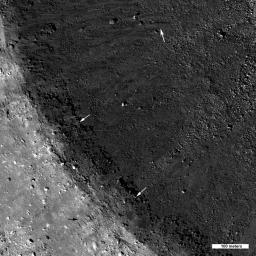
|
Linné Crater
- Click the image above for a larger view
- Full-Res JPEG (1400 x 1400) (491.9 kB)
- Full-Res TIFF (1400 x 1400) (2.0 MB)
Caption:
Linné crater (2.2 kilometers, or 1.6 miles, diameter) is a beautifully preserved young mare crater. Small white arrows indicate layering preserved just below the rim; these rock outcrops probably represent discrete lava flow deposits.
Since the Moon has no atmosphere, no wind, and no rain, features on the surface are preserved for millions of years. The exact age of Linné crater is not known, although it is thought to be less than ten million years old. The new LROC images show a richness of detail that confirm this young age. The small black arrows on the rim point out small delicate fractures (lower left of opening image) that formed as the crater walls slumped inward. Also note the frozen impact melt flows amongst the boulders strewn along the steep inner wall (large white arrow).
Background Info:
NASA's Goddard Space Flight Center built and manages the mission for the Exploration Systems Mission Directorate at NASA Headquarters in Washington. The Lunar Reconnaissance Orbiter Camera was designed to acquire data for landing site certification and to conduct polar illumination studies and global mapping. Operated by Arizona State University, LROC consists of a pair of narrow-angle cameras (NAC) and a single wide-angle camera (WAC). The mission is expected to return over 70 terabytes of image data.
Cataloging Keywords:
| Name | Value | Additional Values |
|---|---|---|
| Target | Moon | |
| System | Earth | |
| Target Type | Satellite | |
| Mission | Lunar Reconnaissance Orbiter (LRO) | |
| Instrument Host | Lunar Reconnaissance Orbiter | |
| Host Type | Orbiter | |
| Instrument | Lunar Reconnaissance Orbiter Camera (NAC) | |
| Detector | Narrow Angle Camera (NAC), Wide Angle Camera (WAC) | |
| Extra Keywords | Atmosphere, Crater, Grayscale, Impact | |
| Acquisition Date | ||
| Release Date | 2010-07-06 | |
| Date in Caption | ||
| Image Credit | NASA/GSFC/Arizona State University | |
| Source | photojournal.jpl.nasa.gov/catalog/PIA13246 | |
| Identifier | PIA13246 | |
